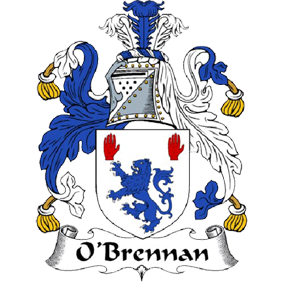Ancient Ireland Name: Ó Brennan
Clan Motto: Neart agus Dílseacht – Strength and Loyalty
Introduction to the Ancient Ireland O’Brennan Clan
The Ancient Ireland O’Brennan Clan holds a storied place in Irish memory. Known in Gaelic as Ó Brennan, the lineage intertwines with early Connacht dynasties. Archaeological finds confirm settlement continuity from the late Iron Age. Medieval annals record chieftains who balanced war craft with ecclesiastical patronage. Diaspora waves later spread the surname to distant continents, yet customs endured. Modern DNA studies reconnect global descendants with their Galway and Clare roots. Revived clan societies now safeguard oral traditions once shared beside peat‑lit fires. Annual gatherings celebrate martial songs alongside genealogy workshops and language lessons. Documentary filmmakers increasingly spotlight the clan’s role in regional folklore. Their distinctive crest remains a potent emblem of resilience and community pride. This article explores origins, documents, leadership, warfare, territory, and modern renaissance.
Origins and Early History of the Ancient Ireland O’Brennan Clan
Limestone ridges near the Shannon sheltered the clan’s first timber roundhouses. Pollen cores reveal rotations of barley, emmer, and meadow grazing by 500 CE. A ninth‑century ogham stone inscribed with the surname anchors legend to artifact. Christian scribes praised a seamless shift from druidic rites to monastic patronage. Tanistry law by 950 CE affirmed stewardship over riverside meadows. Such rootedness forged an identity inseparable from ancestral soil. Family lore still recounts a druid sentinel roaming these ridges each Samhain. Archaeologists continue mapping post‑holes of forgotten roundhouses.
First Recorded Mentions of the Ancient Ireland O’Brennan Clan
The Annals of Inisfallen first cite the clan alongside Clontarf warriors in 1014. English clerks anglicised surnames for tax rolls, often omitting the ‘O’’ to simplify records. Emigrants shortened names to fit ship manifests and overseas bureaucratic ledgers. Parish priests standardised spellings to English phonetics during literacy campaigns, dropping prefixes. Everyday forms—rail tickets, school registers, army enlistments—favoured concise versions, hastening the change. Business signage and typewriter constraints later cemented the streamlined spelling that coexists with the ancestral form. Genealogists now cross‑reference these variants to rebuild scattered family trees. Digitised manuscripts reveal fresh spellings each year, enriching surname databases.
Leadership and Legacy of the Ancient Ireland O’Brennan Clan
Chieftains were elected tanists prized for wisdom and martial skill. Lughnasa hill courts ratified treaties and mediated land disputes. Bards honoured leaders who balanced generosity with battlefield courage. Strategic marriages extended influence without bloodshed. Hereditary ollamhs memorised genealogies thwarting rival claims. Such governance preserved unity through Tudor and Cromwellian storms. Modern clan councils echo this model, rotating chairpersons every three years. Mentorship programs pair elder historians with youth eager to carry ceremonial roles.
Warfare and Valor of the Ancient Ireland O’Brennan Clan
Warriors favoured javelins and wicker shields ideal for limestone terrain. Summer fairs doubled as militia musters with athletic contests. Bardic poems laud daring cattle‑raid recoveries that restored honour. Alliances with O’Connor kings provided seasoned kern for major campaigns. Sacred truces paused conflict during Imbolc and Samhain festivals. These codes forged a martial ethos tempered by ritual ethics. Re‑enactment groups today recreate these skirmishes for heritage gatherings. Martial‑arts researchers study the tactics to inform living‑history demonstrations.
Alliances and Ethics of the Ancient Ireland O’Brennan Clan
Border pacts reduced costly skirmishes and stabilised pasture access. Dowry agreements frequently included shared fishing weirs along the Shannon. Joint levies repelled coastal Viking raids in the ninth century. Norman charters reveal tactical fealty swaps preserving self‑rule. Customary law forbade betrayal of sworn allies under penalty of exile. Diplomacy, not conquest, underpinned the clan’s long survival. Today, conflict‑resolution workshops cite these precedents in community mediation. Historians hail the clan as an early exemplar of reciprocal hospitality.
Homelands and Territory
Core lands spread across today’s Galway and Clare limestone karst. Pilgrims visit holy wells dedicated to Saint Brigid each spring. Stone circles align precisely to solstice sunsets on Burren plateaus. Eighteenth‑century estate books show adaptation to tenant farming. Modern heritage trails overlay medieval boundaries using QR codes. Council grants fund preservation of ringfort ramparts and crannógs. Eco‑tours highlight how ancient grazing shaped the Burren’s biodiversity. Community archaeologists now map souterrains once used for refuge and storage.
Modern Renaissance
Diaspora gatherings alternate between Galway, Boston, and Sydney. DNA studies verify kin links guessed from parish registers. Online forums crowd‑source translations of Connacht Irish poems. Scholarships aid students researching Celtic archaeology and language revival. Restoration programs revitalise abbeys once protected by clan warriors. The Ancient Ireland O’Brennan Clan now marries technology with ancient pride. Virtual‑reality tours let distant cousins explore ancestral lands from home. Crowdfunding supports digitising parchment deeds housed in regional archives.
To discover more Ancient Ireland Clan Names click here.

